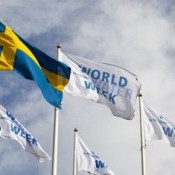Market Solutions Gain Traction at World Water Week
The 20th World Water Week wrapped up in Stockholm on Saturday with increased attention on financing mechanisms that promote healthy water by rewarding good water stewardship. We’ve put together this brief guide to help you find material from the relevant panel discussion – and to offer you a glimpse at some of the concrete solutions unveiled these past seven days.

EM on Deutsche Welle
New York’s groundbreaking payment for watershed services scheme offers a clear demonstration of the potential for cleaning water by paying farmers to act as guardians of the watershed. EM’s Tracy Stanton discussed the scheme with Nathan Witkop of Germany’s Deutsche Welle Radio on the fringes of World Water Week.
Click here for the interview.
A functioning society needs reliable supplies of clean drinking water, but this unappreciated commodity is becoming increasingly scarce, in part because the cost of using it has not been integrated into the economy. World Water Week examined solutions to the global crisis in water quality, and here’s our take on those solutions focused on financing.
12 September 2010 | STOCKHOLM | The 20th World Water Week wrapped here with increased attention on financing mechanisms that promote good water quality by rewarding good water stewardship. Many of the workshops and panel discussions focused on payments for watershed services, water footprinting, and other methods of fighting water pollution by recognizing the economic value of clean water. The Nature Conservancy and Coca Cola even unveiled unveiled the results of a recent application of the water-footprinting methodology that we will be examining in more detail this coming week.
Accessing Material Online
Several workshops have added to the understanding of complex issues regarding water pollution and payments for watershed services, and the Stockholm Water Institute has posted summaries on the web site it created for the event, www.worldwaterweek.org. They also provided daily coverage of seminars and workshops, which you’ll find here.
Groundbreaking Workshops
The Groundwater Abstraction and Pollution workshop dove into the role of regulation through the assignment of water rights or permits and the potential of tradable water rights, while the Minimizing Land Use Based Water Pollution workshop explored, among the many scientific-based assessment of water quality impacts, the role of financial mechanisms, including nutrient trading and payment for watershed services, where we presented our own State of Watershed Payments report.
A workshop devoted to Latin America provided an opportunity to showcase the lessons learned from the successful implementation of water funds which are financial models used to connect downstream users of watershed services with the upstream providers or land stewards.
Turning Words into Action
Water and Climate were center stage in a discussion focused on what next in the post COP 15 with an eye toward COP 16 in Cancun in November, and several initiatives that were either unveiled or fleshed out in Stockholm will be revisited there.
‘Water Footprinting’ (the total volume of freshwater consumed either directly and indirectly to produce a product) was discussed in the context of what governments can do to reduce humanity’s impact on water resources.
Wednesday’s agenda brought focus to various approaches to improving water use efficiency through recycling and reuse and a feature on the potential tools to reform which looked into recent work by McKinsey and Company on the development of a “water cost curve” which is intended for use by investors and policy makers to arrive at least-cost solutions to achieving water security.
There was a lively panel discussion highlighting the many developing footprinting and reporting standards aimed at the corporate sector. The panelists included corporate perspectives from Ceres, PepsiCo, Ch2M Hill, Borealis, Unilever a lone NGO, the Nature Conservancy and academia. The panel was chaired by the World Business Council on Sustainable Development.
The panel discussion was punctuated by the earlier launch of a new report by the Coca Cola Company and the Nature Conservancy, which outlined Coke’s efforts to conduct a water footprint of a 0.5 liter PET bottle of Coca-Cola produced by Coca-Cola Enterprises Inc. (CCE) in the Netherlands; beet sugar supplied to Coca-Cola bottling plants in Europe; and Minute Maid orange juice and Simply Orange produced for the North American market. The report is intended to share the lessons learned by Coke with others interested in the practical application of a footprinting exercise.
Not to be outdone by Coke, PepsiCo promoted its water stewardship efforts through their report, “Water Stewardship: Good for Business-Good for Society,” which was released earlier in 2010. The report features a new set of goals that focuses on improving water efficiency within the company by 20 percent per unit of production by 2015; striving for a “positive water balance” in operations in water stressed areas and providing access to safe water to three million people in developing countries by the end of 2015. This in addition to PepsiCo’s program to fund innovation through it’s online grant program Refresh.
Thursday and Friday’s sessions featured a workshops devoted to shortcutting historical pollution trends and incorporating ecosystem protection and functioning into policy discussions on sustainable water quality efforts.
The corporate sector was center stage again in a session giving an update on the CEO Water Mandate, a public-private initiative launched in 2007, designed to help companies in the development, implementation and disclosure of water sustainability policies and practices. The session included a mix of stakeholder input from the likes of Coca Cola, WWF, the Pacific Institute, SABMiller, Unilever, Ceres and the Alliance for Water Stewardship, to name a few.
Additional resources
Please see our Reprint Guidelines for details on republishing our articles.

